PLAN COLOMBIA: Learning from a Light-footprint “America Second” Military Strategy
Michael A. Marra and Douglas W. Bennett
A retrospective 20 years after its inception.

"We make war that we may live in peace."
-- Aristotle
The United States has intervened repeatedly in the southern hemisphere for a myriad of reasons, but primarily to address growing problems metastasizing at the “Southern strategic approaches” to American territory. While today’s problem of 2015-2020 is one of human mass migration, the previous crisis of 2000 to 2010 stemmed from of an epidemic of illicit drugs. This threat was so pernicious at that period, the United States felt compelled to act with our partner nation of Colombia. With a combination of all instruments of national power, a holistic strategy with a small but powerful military theme emerged.
The strategy, called PLAN COLOMBIA, had a very distinct American military approach to integrating with the Colombian military to achieve greater effects with a minimum of U.S. personnel as military advisors. A set of lines of operation over a roughly 15-year period, from 2000-2015, backed by the Colombian Army with a strong political and national will to fight and win, better technology, and effective intelligence proved decisive in the internal defense of the Colombia. This decisive military victory enabled the Government of Colombia to survive and improve governance in the nation. While the military action did not totally “solve” the cocaine production and importation problem from Colombia, it enabled the government to continue to survive and persist in fighting the illicit drug problem. This study found no evidence any other approach would have garnered such positive results, and that the credit for saving the nation of Colombia rests primarily with the military efforts of PLAN COLOMBIA, backed by diplomatic, economic, and informational endeavors.
Roadmap – The Military Lessons of Plan Colombia
This study will examine the strategic environment of the era, the strategic problem facing Colombia and the United States, and their bilateral strategic approach called PLAN COLOMBIA. Subsequently, it will examine the military strategy, and put emphasis on the military lines of operation, the keys to military success, which set the stage for a political solution. Examination of the results, outcomes, and shortcomings of PLAN COLUMBIA, will help derive the lessons learned from that period of history, and may provide a “roadmap” for future U.S. military support in matters of foreign internal defense through security cooperation, security assistance and security force assistance, otherwise known as “Building Partner Capacity.”
While many books, articles, and essays already exist about the political, social, legal, and civil aspects of this conflict, few studies provide details of the intensive military efforts toward the restoration of the Colombian Government. This study will primarily examine military actions in the context of the other aspects, such as the political, legal, and interagency aspects influencing the war, which are well-documented elsewhere many times over. This study takes the minority view that this military intervention is an example of a decisive military victory leading to conflict termination, demobilization, disarmament, and the re-integration of insurgents back into the society of the Colombian population as law-abiding citizens. The research here relies heavily on the testimony of 10 first-person accounts who were involved in the policy, strategy, operations, and tactics of the conflict in Colombia. Having studied this conflict for 10+ years, the authors postulate that no other approach outside of direct military action would have allowed the Government of Colombia to survive as an independent nation-state.
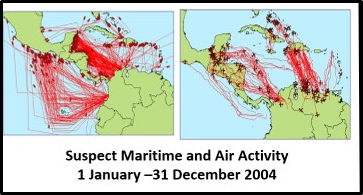
Maritime and Air Tracks, suspected drug smuggling routes as plotted by US Southern Command, 2004[i]
The Strategic Environment
The post-Cold War unipolar environment of the mid - 1990’s marked a rare peacetime strategic inflection point for the United States. The Clinton Administration sought a “peace dividend” in the aftermath of the Cold War and began to focus inwardly in an attempt to address many of America’s internal challenges. One of these challenges was the rampant illicit drug crisis ravaging the nation from the previous several decades. Juxtaposed with this internal crisis was a series of seemingly reluctant, casualty-adverse foreign military interventions.[ii] Following the spectacular military success of the Persian Gulf War of 1990-91, these interventions ended badly, inconclusively, or developed into protracted conflicts. While U.S. Presidents often campaign on domestic issues, framing their platforms on matters they believe are important to the citizens of the United States, history shows they typically, and usually reluctantly, become drawn into international conflicts, and the era of the mid to late 90’s was certainly no exception. Our long-term partner in South America, Colombia, was in severe crisis, causing some national security experts to fear its inevitable collapse into a failed state, and it was in desperate need of external assistance. Given this strategic environment, how could the United States render support to a potentially failing ally without committing to another major military force deployment amid a hypercritical domestic audience?
The Problem - Why Colombia?
So, what was the strategic problem and why did this matter to the United States? Why did the United States feel compelled to act to mitigate and ameliorate this complex and adaptive problem in Colombia?
''Colombia confronts a drug emergency that directly affects the United States.'… In spite of aggressive counter-drug efforts, coca cultivation in Colombia has increased 140 percent over the last five years. This massive rate of increase threatens to reverse the counter-drug successes in Peru and Bolivia.''
-- President Bill Clinton, 24 Aug 2000, Interview with NY Times[iii]
As a matter of strategy, the United States sees national security and national defense as an “away game” to borrow from popular sports culture. The strategic culture of the United States is to mitigate or solve problems abroad, at our strategic approaches and not at our borders or within the continental United States. This is good strategy, if a nation has the capacity to employ it. Given that paradigm, confronting a massive drug influx at its origins is the preferred method. In this way, the Clinton Administration saw fit to address two major problems in the 1999-2000 timeframe. First, confront in the source zones the massive drug problem, particularly cocaine, flowing into the United States. Second, come to the aid of a key long-term partner in South America, Colombia, facing a powerful narco-insurgency in the form of the Revolutionary Armed Forces of Colombia, also known as the FARC.[iv]
The FARC, known in Spanish as Fuerzas Armadas Revolucionarias de Colombia—Ejército del Pueblo, has origins back to the early 1960’s as a Marxist-Leninist peasant guerrilla movement for agrarianism and anti-imperialism using a panoply of military techniques, tactics and procedures including unconventional methods such as politically motivated violence (terrorism).[v] The numbers are difficult to ascertain, but estimates from 18,000 to 26,000 fighters made up the core of the fighting force of the FARC.[vi] It is well-known the FARC drew much of its resources through the cultivation, production and sale of cocaine to fund its war against the Government of Colombia. The guerillas’ main means of financing was through the drug trade including both direct and indirect participation; taxation, administration, or control of areas of production and trafficking. A large but often difficult to estimate portion of funding comes from the taxation of businesses and even local farmers, often lumped in with or defined by its opponents as extortion.[vii] However, while the FARC had the rhetoric of an insurgency bent on delivering a “better peace,” the reality was far from it. Evidence points to a narco-insurgency whose leaders profited greatly from the sale of cocaine and who in fact wanted nothing more than a semi-failed state, which would enable the FARC to proceed with their nefarious activities unimpeded by law enforcement or a viable justice system.
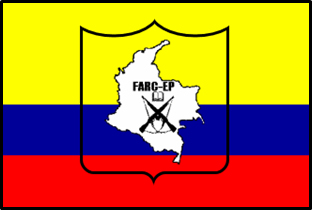
Revolutionary Armed Forces of Colombia flag
“Despite the toppling of the notorious Medellín and Cali drug cartels in the early 1990s, Colombia’s security situation began to worsen as the decade came to a close as drug trafficking, organized crime, and internal armed conflict expanded to produce critically high levels of instability. In 1998, for example, Colombia registered some 58 homicides per 100,000 residents, as well as nearly 2,400 kidnappings, making it the global leader in both categories. By 1999, a failed peace effort had left Colombia’s most powerful guerrilla group—the Revolutionary Armed Forces of Colombia, or Fuerzas Armadas Revolucionarias de Colombia, better known as FARC—in control of territory roughly the size of Switzerland, with 20,000 fighters under arms, an annual income of $400 million from the illegal drug trade, and another $500 million from its other illicit activities. As noted by Juan Carlos Pinzón, Colombia’s former national defense minister and its current ambassador to the United States, “In the latter half of the 1990s, the guerrillas were capable of conducting multi-battalion size conventional set piece battles, and controlled large swaths of coca crop growing areas and drug routes, where they forced the displacement of entire towns.” In short, the FARC had become a de facto government in broad swaths of Colombia and represented an existential threat to the Colombian state. Paramilitaries further exacerbated the security situation in Colombia. In 2000, the United Self-Defense Forces of Colombia—Autodefensas Unidas de Colombia, or AUC—the country’s largest paramilitary network, was estimated at nearly 30,000 combatants. The AUC’s operations were funded largely through drug trafficking proceeds—nearly 70 percent—and private-sector financing, and it was deemed responsible for the murder, rape, kidnapping, extortion, and displacement of tens of thousands of Colombians. The other large guerrilla group, the National Liberation Army—Ejército de Liberación Nacional, or ELN—was also in the mix at the turn of the 21st century. In 2000, the ELN had nearly 5,000 fighters in its ranks and routinely engaged in assassinations, kidnappings, bombings, and hijackings against its targets. Between 2000 and 2007, the ELN was responsible for the death of 153 hostages and more than 3,000 kidnappings. All told, the government of Colombia lacked control over many departments—the functional equivalent of states—in the country and lacked any presence in 169 of the country’s 1,099 municipalities in 2002. This lack of control and the internal armed conflicts feeding it also resulted in Colombia becoming home to the world’s largest internally displaced population—4.7 million people by 2012—a distinction it has only recently ceded to Syria.” [viii]
Enter PLAN COLOMBIA
“Peace is the most urgent task on our country’s agenda and the best social contract we can make with the future.”
-- President Andres’ Pastranas’ inaugural address, 1998.[ix]
What was the concept of PLAN COLOMBIA and how did the United States support this initiative? Why did United States President Bill Clinton and Colombian President Andres’ Pastrana sign a historic long-term agreement, essentially escalating a simmering insurgency into a more confrontational civil war?
Colombia is a key U.S. ally in South America. With diplomatic relations that began in the 19th Century following Colombia’s independence from Spain, the countries have enjoyed close and strong ties. Because of Colombia’s prominence in the production of illegal drugs, the United States and Colombia forged a close partnership over the past two decades. Focused initially on counter narcotics, and later counterterrorism, the program called PLAN COLOMBIA laid the foundation for a strategic partnership that has broadened to include sustainable development, human rights, trade, regional security, and many other areas of cooperation. Between FY 2000 and 2016, the U.S. Congress appropriated more than $10 Billion USD in assistance from the U.S. State Department and Department of Defense accounts to carry out Plan Colombia and follow-on strategies.[x]
Plan Colombia was a bilateral initiative between the United States and Government of Colombia “to reduce the cultivation, processing, and distribution of illicit narcotics in Colombia and improve the security climate in Colombia by reclaiming control of areas held by a number of illegal armed groups[xi] that was signed into law by President Bill Clinton in 2000. A more detailed description of the transaction is stipulated in a Congressional Research Report below.
“In 1999, Colombia’s then-President Andrés Pastrana, who served from 1998 to 2002, requested assistance from the United States to help Colombia combat its security crisis. This assistance effort would eventually become Plan Colombia. In 2000, an original $1.3 billion in U.S. assistance was approved by a Republican-led U.S. Congress and signed into law by former President Bill Clinton with the goal to reduce coca cultivation, drug production, and drug trafficking by 50 percent in the first six years. Plan Colombia’s objectives shifted over time with the reorientation of U.S. national security policy after September 11, 2001, and with Colombia’s election of President Álvaro Uribe, who served from 2002 to 2010. President George W. Bush requested and received from Congress authorization to assist the Colombian government’s efforts against the FARC, ELN and AUC—all deemed Foreign Terrorist Organizations by the United States. Assistance provided to Colombia also expanded— from $276.2 billion in fiscal year 2001 to $560.4 million in FY 2002. It increased again in FY 2003 to $808.1 million before holding steady between approximately $600 million and $700 million per year through FY 2010. The elections of U.S. President Barack Obama and Colombian President Santos ushered in another rebalancing of U.S. cooperation to reflect changing realities in Colombia, with a greater percentage of U.S. assistance being dedicated to economic development and the strengthening of Colombian rule of law institutions. By 2015, the United States had invested $10 billion in improving security and stability in Colombia. Underscoring the excellent return on investment of Plan Colombia, during roughly the same time period, the United States spent $1.6 trillion on combat and reconstruction in Iraq and Afghanistan from FY 2001 to FY 2014, or a rough average of $10 billion every 29 days. Again, crucial to Colombia’s turnaround, Colombian investment in its security far outpaced U.S. investment. Even leaving aside the fact that the hard work of enhancing Colombia’s security has been carried out by Colombians at tremendous personal sacrifice, Colombia’s financial contribution to Plan Colombia constitutes 95 percent of the total. That level of Colombian commitment was made possible, in part, by a recognition by the country’s economic elites that investing in the Colombian state and the viability of their nation through paying more in taxes was in their long-term interests.”[xii]
After the U.S. election and transition to the George W. Bush Administration, a new National Security Presidential Directive number 18 supplanted President Clinton’s Presidential Decision Directive 73.[xiii] However, this study, based on numerous interviews with officers from the Department of State, the U.S. Army, and the Colombian Army, strongly indicates that the events of 9/11 changed the security environment, when the focus of this plan shifted from one of counter narcotics to counterterrorism, with the FARC and their associates as a main focus for a military intervention.[xiv] While perhaps the topic of another study, it is critical to note the events of 9/11 in the United States unintentionally accelerated the military intervention in Colombia.
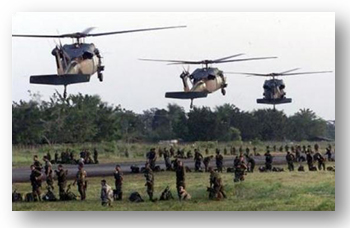
U.S. Blackhawk Helicopters and Colombian Army Infantry, 2007[xv]
The Military Strategy of Plan Colombia
“For security you need more soldiers, you need more policemen, you need more vehicles, you need more planes, you need more guns, you need more communications.”[xvi]
-- Alvaro Uribe, President of Colombia
How did military strategists in Colombia and the United States address the operational problem writ large? How did they frame this approach at the strategic level of United States interests in this conflict?
The approach from the start was “by, with and through” the Government, National Police and Army of Colombia. A major point of this study is to clearly understand PLAN COLOMBIA was a design of the Colombians for the Colombians, with United States involvement as a significant but supporting element. This is the primary reason for the plan’s success – the backing of the political and national will of the government, population, and military of Colombia first, then with U.S. material and non-material support. Without the support and backing from the Colombian people, this plan would not succeed. Although some credit goes to the U.S. Embassy in Bogota, including the Ambassador, the many foreign services officers, and the Military Group resident in Colombia for promulgating this strategy with the Government of Colombia, it is the Government of Colombia who deserves the credit, for the future of their nation was in the balance. While many Colombian Presidents provided key national leadership in Colombia during the conflict, it was President Alvaro Uribe who escalated the military element of power at the appropriate time to secure the victory and emerged as one of the heroes of this turbulent decade in Colombia.
Part of the strategic culture and security strategies of the United States is to “Build Partner Capacity” in other nations for the mutual benefit of that nation and the United States. Between the Department of State (which includes U.S. Agency for International Development), who has the lead in security sector activities vis-à-vis Title 22 of U.S. Code, and the Department of Defense, who implements security agreements vis-à-vis Title 10 of U.S. Code, there are legal authorities that enable both the departments to export material and non-material support to accomplish this capacity building. Under the rubric of Building Partner Capacity (BPC) flow three major efforts between the departments consisting of programs of record entitled Security Assistance (SA), Security Cooperation (SC) and Security Force Assistance (SFA).[xvii]
Due to the ongoing military efforts in Somalia, Bosnia and Haiti in the mid- to late 1990’s, and their less-than decisive outcomes, there was little political or domestic appetite for another major force deployment of United States military. “Boots on the ground” in another seemingly, “internal conflict” was not politically feasible. Thus, the Clinton Administration opted for an indirect military role in the Colombian conflict. On the scale of national interest, this was between “important” and “vital” due to two main issues – the fragility of the Colombian government in South America, and the influx of cocaine to the United States.[xviii] Subsequently, the “ways” the United States would go about assisting Columbia in the military sphere was through these “BPC” programs mentioned earlier.
Advising, training, and educating, in addition to better technology, comprise the “means” in this strategy. Given this approach, the U.S. military was fully prepared to back the Colombian Army’s strategic military approach. Since many of the senior Colombian Army officers received Master of Arts degrees in strategic studies while attending senior joint professional military education at U.S. war colleges in Carlisle, PA and Washington, DC, the planning cultures were well-aligned to mutually support a unified Colombian and American military approach to combating this insurgency.
Pictured below are original military derivatives of PLAN COLOMBIA from senior Colombian Army Officers depicting the design methodology of the grand approach to confronting the narco-insurgency. The overall military strategy consisted of these elements focusing on the “Six M’s” as identified by the Colombian military. The “Six M’s” are specifically; leadership, finances, mass (the FARC camps), Methods (aimed at disruption), Structure (the hierarchy from end-to-end), and of course, the ideology of the narco-criminal enterprise. This ideology was pernicious in that it never aspired to supplant the government with anything that would provide for the population. The ideology only wanted an under-governed state to the point it could operate the nefarious activities to produce more profit from illicit narcotics.
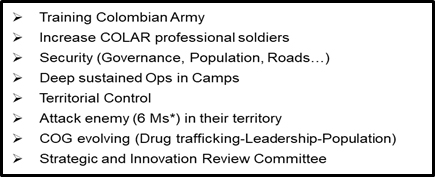
Source: Senior Colombian Army Officers attending the U.S. Army War College from 2012-2019[xix]
These three primary source documents illustrate a classic “Ends, Ways, and Means” type strategy formulation model still taught at the United States Army War College to Colombian Officers who attend each year. The following two diagrams are both examples of the military strategic thinking invested in this effort, which yielded positive and decisive results within years.
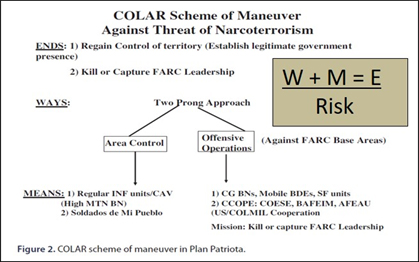
Source: “COLAR (Colombian Army) Scheme of Maneuver” - Senior Colombian Army Officers attending the U.S. Army War College from 2012-2019[xx]
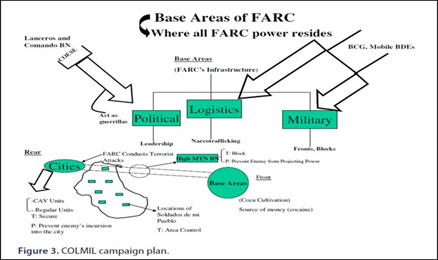
Source: “COLMIL (Colombian Military) Campaign Plan” - Colombian Officers attending the U.S. Army War College from 2012-2019[xxi]
The Lines of Operation in PLAN COLOMBIA
How did the Colombian combined military and police forces decisively defeat the narco-insurgency soon after the implementation of PLAN COLOMBIA? What were the specific “lines of operation” to enable this military strategy to be successful and bring the narco-insurgency to the point the FARC agreed to peace talks on the Government of Colombia’s terms?
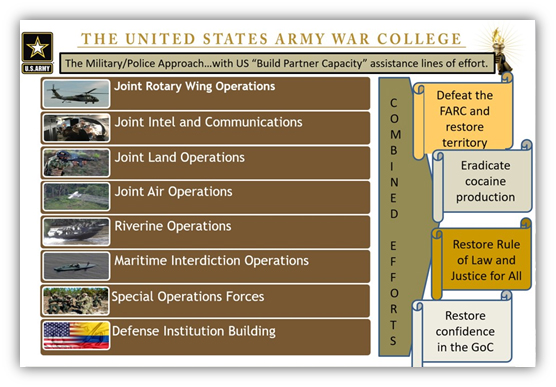
Lines of Operation for PLAN COLOMBIA[xxii]
In short, there was no “silver bullet” or panacea. However, the combined military instrument of power in all domains of conflict, nested in the framework of a political and interagency approach to confronting the narco-insurgents, was the decisive instrument in this conflict. A series of presentations and engagements with U.S. Army Colonel Christopher W. Muller, a foreign area officer (FAO) who served for many years in both the nation of Colombia and at United States Southern Command (USSOUTHCOM) in Miami, provide a more complete understanding of a complex plan to assist the Colombian Army and National Police as described in the following section of this study.[xxiii] What makes this military effort remarkable is U.S. advisors, like Colonel Muller, were accomplishing three major tasks to build the capacity of the Colombians – build institutional capacity, build technological capability, and most importantly, build new counterinsurgency doctrinal capability and capacity while the Colombian Army was engaged in active combat inside their own nation. This is one of the most difficult of all military missions – fight an insurgency while trying to build a national military. The following major lines of operation underpin the overall military strategy depicted earlier.
Joint Rotary Wing Aviation (Helicopters): To gain the operational advantage against the insurgency, the Army and National Police had to be able to gain access to the territory affected and controlled by the insurgency. The best was to do this was through the air, as Colombia is a nation of very mixed terrain – mountains, rain forests jungles, plains, and urban areas – the complete gamut of terrain. Joint rotary wing aviation provided the Colombians with consistent and responsive air mobility. Both the UH-60 Blackhawk and the UH-1 Iroquois helicopters provided by the United States enable the Colombians a decisive advantage over their adversaries. However, it was not just the aircraft – the education, training, doctrine, maintenance, supply, and basing was the “total package approach” the United States provided Colombia. While many other nations can sell aircraft, the United States provided a more complete and comprehensive approach to this “security assistance” to ensure the Colombians had the best chance of success.
Joint Intelligence and Communications: One of the many strengths of United States “security cooperation” program is in intelligence, as the United States has many assets it can promulgate in cases like this. The theme of “shared, secure, significant, sustained” ran through this line of effort to encompass both the actionable information, and the technical hardware to disseminate it, meaning modern, secure, and reliable radio and signal systems from the United States. These new operational and tactical networks to the Colombian Army and National Police were instrumental in unity of understanding, effort, and action against the insurgency.
Joint Land Operations: The line of effort that placed Colombian Army the “boots on the ground” was probably the most decisive of all, as nothing could change in this war unless the government starting taking back the lost terrain and controlled it into perpetuity. This was not a temporal occupation, but had to be a long-term systemic presence by Colombian Soldiers and Police. To do this, the United States had to “support joint, combined, and special ops” in Colombia. In other words, security force assistance to conventional Army and National Police forces, Air Forces, Naval/ Coastal/ Riverine elements, and of course, the National Police forces of Colombia. This concept of “unified land operations” is not new, but worked in Colombia due to the increasingly integrated and interdependent relationship between the Army and the National Police.
Joint Air Operations: In addition to rotary wing aviation line of effort mentioned earlier, the domain of the air far above the surface provided a venue for the Colombian Army and Air Force to gain another decisive advantage over the insurgency. Both manned and unmanned aerial assets from the United States greatly enabled all elements of the Colombian Army and National Police to construct a far clearer three-dimensional situational awareness picture for operational and tactical leaders on the ground. This line of effort to “support precision attack & air mobility” was instrumental in air base defense, close air support, troops in contact support, reconnaissance, medical evacuation, resupply and all the other tradition air-domain activities, to include manual eradication or “aerial spraying” of illicit drug producing crops meant to decrease the production of cocaine. Since the insurgency had no counter-air assets and did not have access to area denial weapons, such as man-portable surface to air missiles, or air defense artillery, this uncontested advantage persisted through the conflict. While weather was an impediment, training to fly at night and in all-weather expanded the capabilities of the Colombians exponentially.
Riverine Operations: Colombia has many deep inland waterways providing a natural distribution of water through the entire country. This network of tributaries also provides riverine mobility to the population and in this instance, the insurgency. This line of effort focused on resources to “secure and patrol the rivers” as any military and police force would patrol any major line of communication, like a road. More education, training, doctrine, and equipment in terms of small boats became the ways and means of this line of effort on the Colombian rivers and streams. A new genre of combat, the Colombian Army was equipped to dominate these estuaries effectively during the conflict.
Special Operations Forces Support: To fight an insurgency, an element of special operations forces is in most cases necessary, and this conflict was no exception. A heavy, but not over-burdensome presence of special operations officers and non-commissioned officers from the United States Army, Navy and Air Force provided “advise and assist” expertise to the Colombian Army and their own special operations forces. Specific roles were direct action, interagency and civil affairs, military information influence operations, and high-value target tactics.
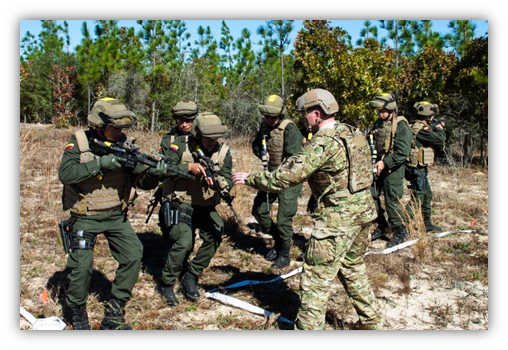
Green Berets, 7th Special Forces Group, training with the Colombian Army[xxiv]
Maritime Interdiction: In addition to the previously documented riverine operations, Colombia developed a line of operations in the deltas and coastal waters around the nation, specifically in the Caribbean Sea and the Pacific Ocean. This “coastal security & interdiction” line of effort focused on counter-narcotics by interdicting seagoing vessels attempting to smuggle the drugs going north and weapons returning south. Again, education, training, and technological support from the United States Navy and Coast Guard in the form of security assistance (the vessels), security cooperation, (the education, training, and exercising) and security force assistance (advising and assisting in the maritime domain) created maritime supremacy for Colombia over the insurgency.
Institutional Strengthening Initiatives: The final, but perhaps the most important line of effort for the longevity of the military strategy of PLAN COLOMBIA, was not at the tip of the spear, but at the other end – the effort of strengthening the institutions underpinning military efforts. With a theme of “Transforming the Force – Enabling the Partnership” – senior military officers and civilians from the Department of Defense deployed to Colombia to build and improve the capability and capacity of the institutions. Areas such as readiness, personnel, modernization, military justice reform, information operations, and humanitarian relief efforts provided the firm foundation which enabled the other lines of effort to successfully implement PLAN COLOMBIA.
Together, synchronized, and integrated, with all the other instruments of national power Colombia had been using, these military lines of operations, which underpinned the military design and strategy, were decisive in ending the conflict with the Government of Colombia in regaining major portions of previously ungoverned areas. While the military clearly tipped the balance of the conflict in favor of the Government of Colombia, debate continues as to interpreting the results of 10 years of insurgency by academics and policy experts against the original objectives, goals, and aspirations of PLAN COLOMBIA.
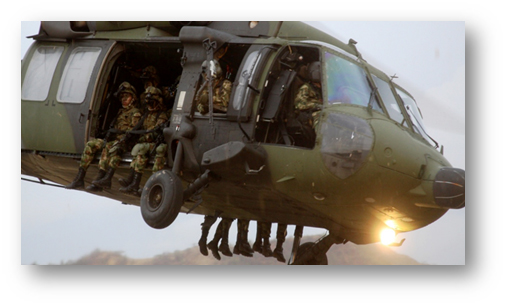
COLAR combating an internal narco-insurgency using UH-60 helicopters[xxv]
Results, Outcomes and Shortcomings
After almost 10 years of combat and a fully integrated approach across the whole-of-government to end the insurgency, what were the results and outcomes, both positive and negative? Depending on a person’s worldview, the alignment of results can support many diverse arguments, but for the purpose of this study and focus of military operations in PLAN COLOMBIA, the outcome is now part of history. By introducing a focused military effort, the insurgency suffered defeat, and peace talks followed.
“Increased security force professionalism and mobility have enabled the Colombian government to expand its reach, particularly in departments that were previously dominated by guerrillas and paramilitary forces. By 2007, for example, all 1,099 municipalities in Colombia had a state presence. With increased state presence has come a decline in overall insecurity. By 2014, Colombia’s homicide rate had steadily dropped to 26.6 homicides per 100,000 people, the lowest level in nearly three decades. In 2014, Colombia also witnessed only 288 kidnappings—compared with the nearly 3,000 in 2000.Increased security capacity also strengthened the government’s hand vis-à-vis the FARC. In 2002, the FARC had approximately 16,000 combatants. By 2007, 4,600 FARC fighters were either killed or captured. By 2010, the FARC had 8,000 fighters, a number that has held steady through 2015. From 2008 to 2010, through targeted strikes, the Colombian government also successfully killed top FARC leaders for the first time in the conflict’s history. Economic and social gains Colombia has made tremendous economic strides during the past 15 years as its security situation has improved. By 2014, Colombia’s gross domestic product, or GDP, had grown to $377.7 billion, compared to $99.88 billion in 2000, making Colombia the third-largest economy in Latin America. Colombia also has seen major reductions in poverty, with the percentage of the population living below the national poverty line, for example, decreasing from 64 percent in 1999 to 28.5 percent in 2014. Extreme poverty has dropped even more precipitously from 23 percent in 2000 to 8.1 percent in 2014. Colombia’s Gini coefficient, the leading indicator of economic inequality, although still high, has narrowed from 58.7 to 53.3 in the past 15 years, an improvement comparable to Brazil’s during that country’s much touted efforts to move millions of people out of poverty and into the middle class.”[xxvi]
The victory was decisive, but not complete – not yet. First, the Government of Colombia had to survive if it was ever to attempt to change the political destiny of the nation in terms of being a government for all people, former insurgents included. A peace agreement resulted from the Colombian military’s victory over the FARC where the Government of Colombia prescribed the terms. Clearly, a democracy preserved after teetering on the brink of collapse. As described above, unemployment and poverty decreased because of a stable government and the diminished number of acts of violence and kidnappings. Tourism and International investment increased as capital investments from around the world saw Colombia as a stable, viable place to invest. International support and cooperation increased as other nations saw the legitimacy of the Colombian Government taking control of their own sovereign nation-state. Most importantly, the Government of Colombia came out of the war as fully legitimate in the eyes of her population. The plan was Colombian led, using its own resources and most importantly, underpinned by their own political will. Military and police growth, professionalization, and key capabilities in special operations, mobility, intelligence, and engineering increased exponentially. While many Colombian soldiers, police and citizens gave their lives in this conflict, the death toll would have been far greater had the insurgency persisted and the level of violence in the pre-PLAN COLOMBIA days left to fester.
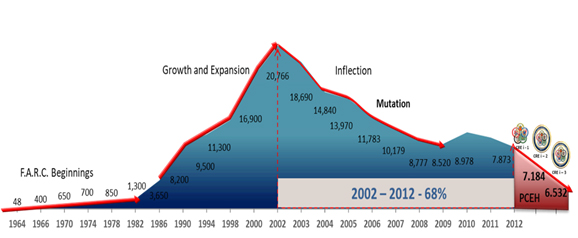
Diagram of FARC forces through the years.[xxvii]
From the U.S. perspective, this was an investment very well designed. The plan, adopted by three Presidential Administrations (Clinton, Bush, Obama) in succession with equal interest and resolve, survived the test of time inside Washington. The strategy and policy transcended the usually divisive American political spectrum.
Perhaps one of the most interesting and positive externalities from PLAN COLOMBIA was not what happened in that nation or in the United States, but in the region. Colombia is now a “net exporter” of security to other Latin American nations. This is a very positive development for the United States in this region. The perception of Colombia as more of a traditional “partner” by many Latin American nations than is the United States in terms of military assistance, advice, and cooperation is pervasive. By 2012, President Obama and President Santos transitioned to the “Action Plan on Regional Security Cooperation.” This plan, a sequel built on the successes of PLAN COLOMBIA, focused on Narco-trafficking, Combating Crime, Strengthening Institutions, and Fostering Resilient Communities.[xxviii] The “Action Plan” focused on capacity building for security personnel in Central American and the Caribbean by Colombian military and police forces seasoned during the war. Colombia assisted Panama, Costa Rica, El Salvador, Honduras, Guatemala, and the Dominican Republic between 2013 and 2017 and trained almost 17,000 individuals.[xxix]
While the successes are legion, what can be made of the shortcomings of the PLAN as often promulgated by the detractors of military intervention of PLAN COLOMBIA? What did NOT work as all had hoped? The topics most often identified as a shortcoming, or failure of the endeavor, center around three main themes – civilian casualties, extrajudicial killings by both the FARC and Government of Colombia, and the most telling of all, that the illicit drugs flowing into the United States had NOT been significantly reduced.
Under the program, according to the Office of the United Nations High Commissioner for Human Rights, an estimated 3,000 innocent civilians were killed by security forces (mainly the army), most of them between 2004 and 2008.[xxx] The amount of civilians killed by the FARC is perhaps ten times that number. Finally, ending the flow of narcotics did not come to fruition.
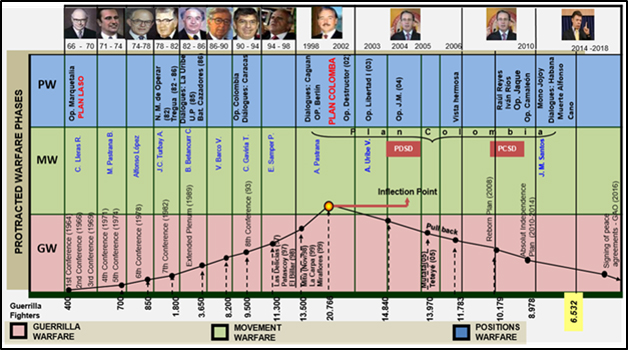
Chronology of the conflict between the Colombian Government and the FARC[xxxi]
“As has happened repeatedly in the four-decade-old drug war, any government pressure applied in a particular location to eliminate drug production or trafficking tends to move it to another place—within a country or to other countries. The so-called balloon effect is rarely disputed, even by proponents of current drug policy. Defenders argue the situation would have been worse otherwise. But if one returns to the original congressional debates about Plan Colombia—the argument that was often made was that going after supply would ultimately result in a change in availability and price on the streets of major U.S. cities—then it is hard to maintain that the $8 billion investment has paid off for the United States.”[xxxii]
Military History Lessons Learned
What can current strategists and military planners learn from the history of this bloody counterinsurgency in Colombia, and how might they adopt and inculcate these lessons today and in the future?
First and most importantly, large numbers of U.S. “boots on the ground” is not the answer when the security partner has the viable means and will to provide for their own military efforts. Putting “America Second” in terms of leadership during another nation’s counterinsurgency is an appropriate U.S. response. While the United States will always find itself in a position to provide military assistance in many forms, this episode in history implores discernment as to which nations are right for “partnering.” Determining which nation to support as a wise investment must only occur after a cleared-eyed assessment and evaluation of the political will of that nation to enter a protracted war-fight, where they are first investing their own blood and treasure. Additionally, the United States must move from a binary “aid-on or aid-off” approach to a graduated scale, where the U.S. security apparatus of the U.S. State Department and the Department of Defense has a series of “levers and rheostats” to adjust up and down to influence partner behavior and progress in these type of conflicts. Perhaps the problems of civilian casualties, extrajudicial killings, and narcotics production would have been addressed by the Government of Colombia more stridently if the United States had a playbook of “carrots and sticks” to wield as the conflict was unfolding, rather than a simple “on and off” switch with regard to military aid.
Next, assisting a preferable partner through our Building Partner Capacity efforts will truly build a long- lasting capacity in that nation, and in turn, build a better strategic partner for the United States. In this case, Colombia not only emerged victorious over the FARC, but did so with a high level of legitimacy, not only internally, but internationally as well. The freely elected leadership has the confidence of the preponderance of their citizens. Furthermore, the effect on the region is also positive, as Colombia is now a net exporter of security to Latin America, something unheard of even 10 years before PLAN COLOMBIA.
Finally, for the United States, the conflict reinforced the idea of addressing problematic issues at their origin, and not at U.S. borders. Protecting the homeland, the top priority of all U.S. Department of Defense (DOD) Geographic Combatant Command (GCC) globally integrated war plans, should start thousands of miles from the continental United States. In PLAN COLOMBIA, the United States helped preserve a democracy that continues to combat drug production and transportation now, many years after this conflict. While illicit drugs are still flowing, the cost and risk imposed on those traffickers is continually increasing.
Conclusions
Many theories and arguments abound pontificating on how the Colombians could have won their country back from the insurgents without the use of a strong military intervention. However, in the end, only the intensive military effort reset security conditions precipitating a political settlement, concluding the fighting. PLAN COLOMBIA was a victory for both Colombia and the United States. While no two insurgencies will ever be the same, the lessons of the history of PLAN COLOMBIA offer new ideas to complex and adaptive problems found in many contemporary insurgencies.
The plan saved the country, and perhaps the region, from devolving into chaos, and significantly reduced the number of killings prevalent before implementation. While the efforts of the plan did not meet all objectives, especially concerning illicit drug eradication, it did perpetuate the viability of the Colombian Government, and helped to further U.S. policy goals and objectives for the hemisphere. All of this through a Colombian plan, backed by the political will of the Colombian people, with strong U.S. political, economic, interagency, and military support, resulting in legitimate governance and a grateful population.
The attainment of this victory came by a decisive element of U.S. military advising and assistance, but not through massive and costly U.S. troop deployments placing U.S. “boots on the ground,” a strategy that did not seem to work well in Somalia, Haiti, and Bosnia during that same period in history. PLAN COLOMBIA is rich in lessons concerning national security policies, military strategies and plans in similar situations now and into the future where U.S. “Building Partner Capacity” efforts abound. Building a nation’s military capacity and capability while simultaneously fighting a dangerous counterinsurgency is perhaps one of the most complex mission sets for any military at any time or any place. Borrowing or replicating major axioms from PLAN COLOMBIA for other areas of the world in similar conflicts vis-à-vis indirect assistance and cooperation is strategically better for all nations concerned, as it establishes political legitimacy while transforming that nations military institutions, dynamic doctrines, and technological capacities.
The future of Colombia is brighter today in 2020 than it was 20 years ago, thanks in large part to those who made the decision to intensify the conflict through military means, ultimately bringing the fighting to a peaceful resolution. Benjamin Franklin once said, “There was never a good war or a bad peace”[xxxiii] – PLAN COLOMBIA, and specifically the military elements, helped shorten the war and extend the peace.
Works Cited
ABC. (2000, 31 Aug). Clinton Announces $1.3B in Aid to Colombia. Washington: American Broadcast Corporation.
Andres' Pastrana, P. o. (1999, June). Speech to the nation. Bogata.
Aristotle. (340 BC). Nicomachean Ethics.
Beittel, J. S. (2019). Background and US Relations (Vol. R43813). Washington: Congressional Research Service.
Clinton, P. W. (2000, August 24). President of the United States. (M. Lacey, Interviewer)
COHA. (2010, July). FARC – Rebels with a Cause? Washington: Council on Hemispheric Affairs.
Colombian-Officers, M., Bonilla-Vasquez, C., Forero, B., Pinto, C., Florez Cuervo, C., Correa Consuegra , B., . . . Diaz Reyes, C. (2012-2019, May 15). Plan Colombia - COLAR perspectives. (P. M. Marra, Interviewer)
Command, U. S. (2004). Suspected Drug Routes from Colombia to the north. Suspected Drug Routes. Deptartment of Defense, Miami.
Dan Restrepo, F. O. (2016, Feb 2). The Unites States and Colombia: From Security Partners to Global Partners in Peace. American Progress Journal, 2-23.
DoD, J.-S. (2017). Joint Publication 3.20 Security Cooperation. Washington: Department of Defense.
Franklin, B. (1773, September 11). Letter to Josiah Quincy.
Galula, D. (1964). Counterinsurgency Warfare: Theory and Practice. Westport, CN: Preager International Security.
Marcella, G. (2003). The US and Colombia: The Joureny from Ambibuity to Strategic Clarity. Carlisle, PA: Strategic Studies Institute Special Series.
Muller, C. C. (2016-2019, May 15). Security Cooperation Officer. PLAN COLOMBIA - security cooperation efforts. (P. M. Marra, Interviewer) Carlisle, PA.
Shifter, M. (2012). Plan Colombia: A Retrospective. Think Tank. Washington: Americas Quarterly.
State-Dept. (2012). US Dept of State, Joint press release on the US Colombia Action Plan on Regional Security Cooperation, April 15, 2012, at. US Department of State. Washington: US State Dept Press.
State-Dept. (2015, March). Colombia: Exporter of Security and Stability. US State Dept Press, US State Dept. Washington: US State Dept Press.
Uribe, A. (2003). Uribe addresses Colombia. Bogata: BrainyQuote.com, BrainyMedia Inc, 2020. https://www.brainyquote.com/quotes/alvaro_uribe_437207.
End Notes
[i] USSOUTHERN COMMAND, “Suspected Drug Routes from Colombia to the North” Department of Defense, Suspected Drug Routes, (Miami FL, 2004)
[ii] Specific U.S. military interventions during this time include OPERATION RESTORE HOPE (Somalia, 1992-1993), OPERATION UPHOLD DEMOCRACY (Haiti 1994), OPERATION DILIBERATE FORCE (Bosnia 1995), and OPERATION ALLIED FORCE (Bosnia/ Kosovo 1999).
[iii]Marc Lacey, Clinton Defends the Outlay Of $1.3 Billion to Colombia, The New York Times, 24 Aug 2000, accessed 9 Feb 2020,.https://www.nytimes.com/2000/08/24/world/clinton-defends-the-outlay-of-1.3-billion-to-colombia.html
[iv] June Beittle, Colombia: Background on US Foreign Relations, Vol. R43813. Washington, Congressional Research Service, 2019, accessed 11 Feb 2020, https://fas.org/sgp/crs/row/R43813.pdf, p. 1.
[v] Michael Shifter, Plan Colombia: A Retrospective, Americas Quarterly, , 2012) accessed 9 Feb 2020 https://www.americasquarterly.org/node/3787
[vi] Dan Restrepo, Frank O. Mora, Brian Fonseca, and Jonathan D. Rosen, The United States and Colombia: From Security Partners to Global Partners in Peace, Center for American Progress, 2016, accessed 9 Feb 2020 https://cdn.americanprogress.org/wp-content/uploads/2016/02/01064932/Colombia-brief.pdf
[vii] CHOA, FARC – Rebels with a Cause?, Council on Hemispheric Affairs, 2010, accessed 9 Feb 2020 http://www.coha.org/farc-%E2%80%93-rebels-with-a-cause/
[viii] Restrepo et al, The United States and Colombia
[ix] Associated Press, New Colombian president has plan for peace, Desert News, (8 August 1998) accessed 11 Feb 2020, https://www.deseret.com/1998/8/8/19395501/new-colombian-president-has-plan-for-peace
[x] June Beittle, Colombia: Background on US Foreign Relations, p 1
[xi] GAO Report, Plan Colombia, (US Government Accountability Office (Washington DC, 2008), accessed 11 Feb 2020, https://www.gao.gov/assets/290/282511.pdf, p. 1
[xii] Restrepo et al, The United States and Colombia
[xiii] Marcella, Gabriel, The US and Colombia: The Journey from Ambiguity to Strategic Clarity, Strategic Studies Institute Special Series, (Carlisle, PA, 2003)
[xiv] COL Christopher Muller, Interview with the author, 2016-2019
[xv] Colombian-Officers, Multiple; Bonilla-Vasquez, COL Pablo; Forero, BG Juan Pablo; Pinto, COL Marcos ; Florez Cuervo, COL Raúl Hernando; Correa Consuegra , BG Juan Carlos; Gomez, COL Franklyn ; Farfan, COL Fernando ; Diaz Reyes, COL Harold, interviews with the author over several years during their attendance at the U.S. Army War College, (Carlisle, PA, 2012-2019).
[xvi] Alvaro Uribe, Uribe Addresses Colombia, BrainyQuote.com, BrainyMedia Inc, 2020, accessed 9 Feb 2020, https://www.brainyquote.com/quotes/alvaro_uribe_437207
[xvii] U.S. Department of Defense, Security Cooperation, Joint Publication 3-20, (Washington DC, U.S. Joint Chiefs of Staff, 2017), accessed 11 Feb 2020, https://www.jcs.mil/Portals/36/Documents/Doctrine/pubs/jp3_20_20172305.pdf
[xviii] There are four categories of intensity of interests: Survival, Vital, Important, and Peripheral. Survival interests are those that represent the single most important interests upon which the very survival of the actor is at stake. Vital interest exists when an issue is so important to an actor’s well-being that its leadership can compromise only up to a certain point. Important interest are significant, but not crucial to the well-being of the actor. Finally, Peripheral interests involve neither a threat to security or well-being of the actor. Adapted from Alan Stolberg, Crafting National Interests in the 21st Century, presented paper at paper at the International Studies Association West conference in San Francisco, CA, September 28-29, 2007.
[xix] Colombian-Officer interviews at USAWC
[xx] Colombian-Officer interviews at USAWC
[xxi] Colombian-Officer interviews at USAWC
[xxii] COL Christopher Muller, Interview with the author, 2016-2019
[xxiii] COL Christopher Muller, Interview with the author, 2016-2019
[xxiv] MAJ Thomas Cieslak, USA, USASOC, 20 Nov 2015
[xxv] Photo courtesy of Colombian Army students obtained during interviews 2012-2019
[xxvi] Restrepo et al, The United States and Colombia
[xxvii] Colombian-Officer interviews at USAWC
[xxviii] U.S. Department of State, Joint Press Release on the United States - Colombia Action Plan on Regional Security Cooperation, Washington DC, 15 Apr 2012, accessed 11 Feb 2020, https://2009-2017.state.gov/r/pa/prs/ps/2012/04/187928.htm
[xxix] U.S. Department of State, Joint Press Release on the United States - Colombia Action Plan on Regional Security Cooperation
[xxx] Michael Shifter, Plan Colombia: A Retrospective
[xxxi] Colombian-Officer interviews at USAWC
[xxxii] Michael Shifter, Plan Colombia: A Retrospective
[xxxiii] Benjamin Franklin, Letter to Josiah Quincy, September 1773, Founders Online, accessed 9 Feb 2020 https://founders.archives.gov/documents/Franklin/01-40-02-0385.
About the Author(s)
Comments
We are committed to…
We are committed to providing our clients with exceptional solutions while offering web design and development services, graphic design services, organic SEO services, social media services, digital marketing services, server management services and Graphic Design Company in USA.
Thank you very much for the…
Thank you very much for the premium account. This account will be useful as students use various aids in their studies. Recently I have been using the website with an essay writing on a book https://samplius.com/free-essay-examples/domestic-violence/ to prepare essay assignments. You know, after using an essay about this book, I wanted to read the whole text. It's an interesting story described by the author.
This a really good piece. …
This a really good piece.
The Colombia experience is an especially important benchmark in evaluating what kinds of interventions--military and non-military both--are most effective in successfully fighting different types of wars. Security is virtually always the sine qua non for success, and this article does a great job of summarizing the security element of the relatively successful Colombia counterinsurgency campaign.
Well done, and thanks for documenting it.


